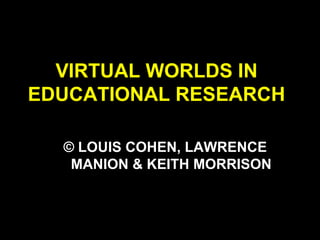
Chapter19
- 1. VIRTUAL WORLDS IN EDUCATIONAL RESEARCH © LOUIS COHEN, LAWRENCE MANION & KEITH MORRISON
- 2. STRUCTURE OF THE CHAPTER • Simulations and virtual worlds • Theoretical bases of simulations and virtual worlds • Applications of virtual worlds • A worked example of virtual world research • Opportunities and limitations • Issues and problems in virtual world research • Using a virtual world and simulations in educational research • Ethical issues in virtual world research • Online tools for data collection from virtual worlds
- 3. SIMULATIONS Main components: • A system of interrelated features in which the researcher is interested and that lends itself to be modelled or simulated. • A model of that system that is often a mathematical analogue. • Deterministic simulations all the mathematical relationships between the components of a system are known. • Stochastic simulations: at least one variable is random.
- 4. COMPUTER SIMULATIONS ARE CHARACTERIZED BY . . . • Modelling and imitating the behaviour of systems and their major attributes; • Enabling researchers to see ‘what happens if’ the system is allowed to run its course or if variables are manipulated; • A mathematical formula that models key features of the reality; • Mathematical relationships that are assumed to be repeating in controlled, bounded and clearly defined situations, sometimes giving rise to unanticipated outcomes.
- 5. COMPUTER SIMULATIONS ARE CHARACTERIZED BY . . . • Feedback and multiple iteration procedures for understanding the emergence of phenomena and behaviours; • Complex phenomena and behaviours derived from the repeated interplay of initial conditions/variables; • Deterministic laws (the repeated calculation of a formula) sometimes leading to unpredictable outcomes.
- 6. ‘WHAT IF’ QUESTIONS • What happens if I change this parameter or that parameter? • What if the person behaves in such-and-such a way? • What happens if I change such-and-such a feature of the environment?
- 7. ATTRACTIONS OF SIMULATIONS • Prediction • Understanding • Explanation • Exploration (in a safe environment) • Virtual worlds are created by the participants and the world emerges from the interaction of the participants. • Individuals can project their own views and values on topics through their avatar and receive the feedback of others in the system.
- 8. ATTRACTIONS OF SIMULATIONS • Economy (they are cheaper to run than the real- life situations); • Visibility (they can make a phenomenon more accessible and clear to the researcher); • Control (the researcher has more control over the simulation than in the real life situation); • Safety (researchers can work on situations that may be too dangerous, sensitive, ethically questionable or difficult in real life natural situations); • Practice (they can be used for training).
- 9. RESERVATIONS ABOUT SIMULATIONS • Artificiality (they mimic life, rather than being the real thing); • Cost (computer simulations can be expensive); • Training of participants (simulations often require considerable training); • Quantitative problems (they may require programming expertise).
- 10. Features and affordances of simulations/virtual worlds Simulations Virtual worlds Modeling / imitating Realizing / Acting ‘What if’ modeling of known variables Few known variables An underlying mathematical construct Minimal underlying constructs Modelled and interpreted reality Catching and manipulating the fine grain of reality Bounded, defined parameters Unbounded and undefined parameters Iteration and feedback to reveal emergent phenomena Human agency as the driver of emergence Repeated interplay of set initial conditions Any set initial conditions rapidly abandoned Unpredictable outcomes sometimes Unpredictable outcomes common Limited simultaneous users Multiple simultaneous users Transience Persistence
- 11. THEORETICAL BASES OF SIMULATIONS AND VIRTUAL WORLDS • Chaos theory • Complexity theory • Immersive experiences and co-presence • Agent-based modelling • Social facts • Artificial life • Social networking • Communicative action (Habermas)
- 12. APPLICATIONS OF VIRTUAL WORLDS • ‘Real life’ scenarios • Collect large amount of data • Store data • Study of human interaction, especially in dynamic, fluid, uncertain or contested contexts • Explore complex behaviour variables • Monitor developments over time • Explore sensitive issues • Explore values and viewpoints
- 13. OPPORTUNITIES • The experimenter has complete manipulative control over every aspect of the situation (e.g. in flight simulators, surgical simulators, training in dangerous environments and decision-making training). • Participants are given a realistic situation in which to act in whatever way they think appropriate. • Inclusion of the time dimension allows the subject to take an active role in interacting with the environment, and enables the experimenter to observe a social system in action, with feedback loops and multidirectional causal connections.
- 14. OPPORTUNITIES • Experiential and active learning; • Encourages motivation and engagement; • Visualization, managing complex environments; • Access to impossible/difficult environments; • Flexibility (can be programmed to offer wide range of situations/stimuli); • Monitoring (sessions can be recorded, examined, evaluated and assessed); • Connect geographically distant participants; • Synchronous and asynchronous.
- 15. CHALLENGES • Creating common research protocols • Use of different IT systems • Assumptions (and cultures) of participants differ • Necessary expertise and training in their use (for researchers and participants) • Sufficient bandwidth • Ability to work with different firewalls
- 16. CONSIDERATIONS FOR EDUCATIONAL RESEARCH • Type of project • Focus of the activity • Carefully formulate the research question • Venue: a private/closed or open environment • Participants • Methodology • Ethical issues • Data analysis • Dissemination
- 17. ETHICAL ISSUES • Vulnerability • Individual risk • Informed consent, especially when dealing with: – Online identities – The nature of communication (public or private) – Security – Confidentiality and privacy – Inworld standards and rules
